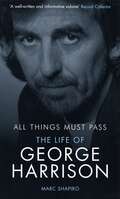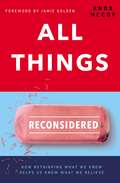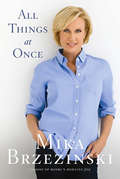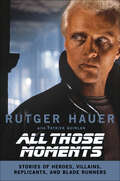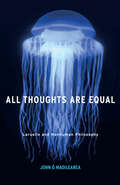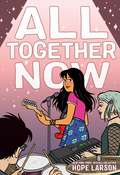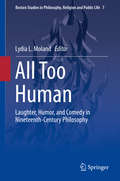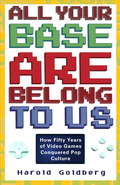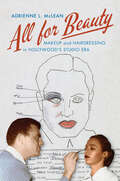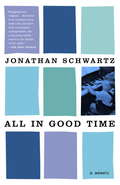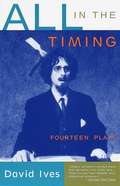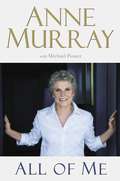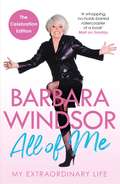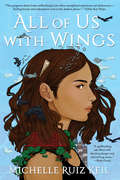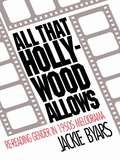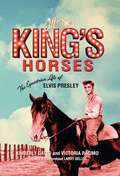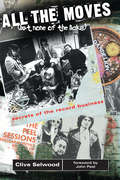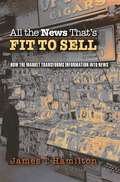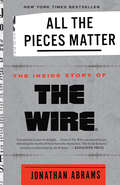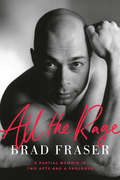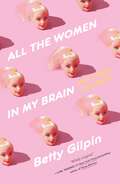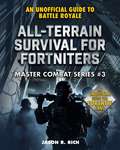- Table View
- List View
All Things Must Pass: The Life of George Harrison
by Marc ShapiroGeorge Harrison was always known as the 'quiet Beatle' As part of the biggest band in pop history, he took a back seat to Paul McCartney and John Lennon, but his talent shone through in the composition of classic songs such as 'Something' and 'Here Comes The Sun'. In his solo career he occasionally threatened to eclipse both John and Paul on the world stage, and he joined forces with Bob Dylan, Tom Petty, Roy Orbison and Jeff lynne to create the massively succsessful supergroup the Traveling Wilburys.However, the success of his professional life was often met by turmoil in his private life, and the loss of first wife Patti to best friend Eric Clapton, the traumatic attempt on his life by a knife wielding intruder and his final struggle against cancer meant that George Harrison's life was nothing if not dramatic.Bestselling author Marc Shapiro has exclusively interviewed friends and former colleagues of the enigmatic guitar legend. This revealing biography reaffirms Harrison's importance as an innovative and hugely talented musician and shows that, as a member of the most important band ever, as well as in his multi-faceted career after the Beatles, George Harrison was no ordinary man.
All Things Reconsidered: How Rethinking What We Know Helps Us Know What We Believe
by Knox McCoyIf we ask just one question, does everything fall apart? In All Things Reconsidered, popular podcaster Knox McCoy uses a unique blend of humor, pop culture references, and personal stories to show how a willingness to reconsider ideas can actually help us grow ourselves, our lives, and our beliefs. In this laugh-out-loud defense of reconsideration, Knox dives into topics like:Are participation trophies truly the worst?Is it really worth it to be a ride-or-die sports fan?Do we believe in God because of the promise of heaven—or the threat of hell?Does prayer work? Is anyone even there?This book is the catalyst we need to courageously ask the questions that will lead to a deeper understanding of ourselves—and God. It&’s time to start reconsidering.
All Things at Once
by Mika BrzezinskiAs the co-host of MSNBC’s popular morning showMorningJoe, Mika Brzezinski has established herself a leading political news journalist and beloved television personality. She daily interviews world leaders—Barack Obama, Hillary Clinton, John McCain—and discusses the major events of the day with guests like Tom Brokaw, Dan Rather, Andrea Mitchell, Chris Matthews, Maureen Dowd, and Tom Friedman. But success hasn’t always come easy for Mika. Growing up the only daughter of a former National Security Advisor, she struggled to find an identity in a family of over-achievers. She found her dream job early on and was hailed as the “It Girl” of CBS, only to be fired just a few short years later. After an unsuccessful stint as a stay-at-home mom, Mika went back to the workplace with encouragement from her 8-year-old daughter. She took a job that seemed a long-shot at best, and against all odds achieved the greatest success of her career. Now, in a time when many women are losing their jobs or struggling to find the perfect balance between work and home, Mika guides women of all ages to a place where they can find peace and fulfillment in their lives. All Things at Onceis a motivational book aimed at women, based on Mika’s own personal and professional triumphs and failures—all of which have led her to her current position as one of television’s most outspoken and respected journalists. Blending the personal with the prescriptive, Brzezinski’s book will address the perpetual question of “having it all” when it comes to work and family; the importance of remaining equally humble in the face of great success and seemingly devastating setbacks; as well as the necessity of knowing and embracing our limitations so that we may transcend them. In the tradition of Gail Sheehy’s classicPassages, this illuminating book shows women how to reach their full potential in all areas of life, and at every stage of their journey. Readers will recognize their friends, their mothers, their daughters, and themselves in this refreshingly honest memoir.
All Those Moments: Stories of Heroes, Villains, Replicants, and Blade Runners
by Rutger Hauer Patrick QuinlanThe Blade Runner star recounts his eventful life and acting career, from joining the merchant navy to working with Hollywood’s biggest directors.Rutger Hauer has dazzled audiences for years with his creepy, inspiring, and villainous character portrayals. He came to mainstream prominence as a machine more human than his creators in Blade Runner, terrified us as a hitchhiker bent on his own death in The Hitcher, and portrayed a lovestruck king who nightly transformed into a marauding wolf in Ladyhawke.While fans are well acquainted with Hauer’s unforgettable on-screen performances, his movie career was nothing compared to his real-life adventures. Born in the Netherlands during WWII, he grew up in a poor family that nourished his creativity. After travelling the world with the Dutch merchant navy, he pursued his love of acting. From working with a traveling theater troupe to his breakout European performance in Turkish Delight and working with legendary directors such as Paul Verhoeven (RoboCop and Basic Instinct) and Ridley Scott (Alien and Gladiator), Hauer has collected All Those Moments here.
All Thoughts Are Equal: Laruelle and Nonhuman Philosophy (Posthumanities #34)
by John Ó MaoilearcaAll Thoughts Are Equal is both an introduction to the work of French philosopher François Laruelle and an exercise in nonhuman thinking. For Laruelle, standard forms of philosophy continue to dominate our models of what counts as exemplary thought and knowledge. By contrast, what Laruelle calls his &“non-standard&” approach attempts to bring democracy into thought, because all forms of thinking—including the nonhuman—are equal.John Ó Maoilearca examines how philosophy might appear when viewed with non-philosophical and nonhuman eyes. He does so by refusing to explain Laruelle through orthodox philosophy, opting instead to follow the structure of a film (Lars von Trier&’s documentary The Five Obstructions) as an example of the non-standard method. Von Trier&’s film is a meditation on the creative limits set by film, both technologically and aesthetically, and how these limits can push our experience of film—and of ourselves—beyond what is normally deemed &“the perfect human.&”All Thoughts Are Equal adopts film&’s constraints in its own experiment by showing how Laruelle&’s radically new style of philosophy is best presented through our most nonhuman form of thought—that found in cinema.
All Together Now (Eagle Rock Series #2)
by Hope LarsonAll Together Now is New York Times bestselling author and illustrator Hope Larson's pitch-perfect graphic novel follow-up for fans of All Summer Long, music lovers, and anyone navigating the ups and downs of friendship.Middle-schooler Bina is having the best time playing in her new band with her friends, Darcy and Enzo. But both the band and her friendships begin to crumble when Darcy and Enzo start dating, effectively relegating Bina to third-wheel status. To make matters worse, Bina's best friend, Austin, starts developing a crush on her . . . one she is not sure she reciprocates. Now Bina must follow her heart. Can she navigate its twists and turns before the lights come up and the music starts playing?
All Too Human: Laughter, Humor, and Comedy in Nineteenth-Century Philosophy (Boston Studies in Philosophy, Religion and Public Life #7)
by Lydia L. MolandThis book offers an analysis of humor, comedy, and laughter as philosophical topics in the 19th Century. It traces the introduction of humor as a new aesthetic category inspired by Laurence Sterne’s "Tristram Shandy" and shows Sterne’s deep influence on German aesthetic theorists of this period. Through differentiating humor from comedy, the book suggests important distinctions within the aesthetic philosophies of G.W.F. Hegel, Karl Solger, and Jean Paul Richter. The book links Kant’s underdeveloped incongruity theory of laughter to Schopenhauer’s more complete account and identifies humor’s place in the pessimistic philosophy of Julius Bahnsen. It considers how caricature functioned at the intersection of politics, aesthetics, and ethics in Karl Rosenkranz’s work, and how Kierkegaard and Nietzsche made humor central not only to their philosophical content but also to its style. The book concludes with an explication of French philosopher Henri Bergson’s claim that laughter is a response to mechanical inelasticity.
All You Need to Know About the Music Business (7th edition)
by Donald S. PassmanThis revised and updated edition provides crucial information on the industry's adaptations to today's technological advances and uncertain economy.
All Your Base Are Belong to Us: How Fifty Years of Video Games Conquered Pop Culture
by Harold GoldbergThrough the stories of gaming's greatest innovations and most beloved creations, journalist Harold Goldberg captures the creativity, controversy--and passion--behind the videogame's meteoric rise to the top of the pop-culture pantheon. Over the last fifty years, video games have grown from curiosities to fads to trends to one of the world's most popular forms of mass entertainment. But as the gaming industry grows in numerous directions and everyone talks about the advance of the moment, few explore and seek to understand the forces behind this profound evolution. How did we get from Space Invaders to Grand Theft Auto? How exactly did gaming become a $50 billion industry and a dominant pop culture form? What are the stories, the people, the innovations, and the fascinations behind this incredible growth?Through extensive interviews with gaming's greatest innovators, both its icons and those unfairly forgotten by history, All Your Base Are Belong To Us sets out to answer these questions, exposing the creativity, odd theories--and passion--behind the twenty-first century's fastest-growing medium.Go inside the creation of: Grand Theft Auto * World of Warcraft * Bioshock * Kings Quest * Bejeweled * Madden Football * Super Mario Brothers * Myst * Pong * Donkey Kong * Crash Bandicoot * The 7th Guest * Tetris * Shadow Complex * Everquest * The Sims * And many more!
All about Almodóvar: A Passion for Cinema
by Brad Epps Despina KakoudakiOne of world cinema&’s most exciting filmmakers, Pedro Almodóvar has been delighting, provoking, arousing, shocking, and—above all—entertaining audiences around the globe since he first burst on the international film scene in the early 1980s. All about Almodóvar offers new perspectives on the filmmaker&’s artistic vision and cinematic preoccupations, influences, and techniques. Through overviews of his oeuvre and in-depth analyses of specific films, the essays here explore a diverse range of subjects: Almodóvar&’s nuanced use of television and music in his films; his reworkings of traditional film genres such as comedy, horror, and film noir; his penchant for melodrama and its relationship to melancholy, violence, and coincidence; his intricate questioning of sexual and national identities; and his increasingly sophisticated inquiries into visuality and its limits. Closing with Almodóvar&’s own diary account of the making of Volver and featuring never-before-seen photographs from El Deseo production studio, All about Almodóvar both reflects and illuminates its subject&’s dazzling eclecticism.
All for Beauty: Makeup and Hairdressing in Hollywood's Studio Era (Techniques of the Moving Image)
by Adrienne L. McLeanEver wonder why so many stars and featured players, male or female, in movies of Hollywood’s “Golden Age” look like they just stepped out of a beauty parlor even if the story places them in a jungle, a hospital bed, or the ancient past? All for Beauty examines how and why makeup and hairdressing evolved as crafts designed partly to maintain the white flawlessness of men and women as a value in the studio era. The book pays particular attention to the labor force, exploring the power and influence of cosmetics inventor and manufacturer Max Factor and the Westmore dynasty of makeup artists but also the contributions of others, many of them women, whose names are far less known. At the end of the complex, exciting, and at times dismaying chronicle, it is likely that readers will never again watch Hollywood films without thinking about the roles of makeup and hairdressing in creating both fictional characters and stars as emblems of an idealized and undeniably mesmerizing visual perfection.
All in Good Time: A Memoir
by Jonathan SchwartzAll in Good Time is a luminous memoir about growing up in the shadow of the golden age of songwriting and Sinatra, from the celebrated radio personality and novelist Jonathan Schwartz."Dancing in the Dark." "That's Entertainment." "By Myself." "You and the Night and the Music." They are part of the American Songbook, and were all composed by Arthur Schwartz, the elusive father at the center of his son's beautifully written book.Imagine a childhood in which Judy Garland sings you lullabies, Jackie Robinson hits you fly balls, and yet you're lonely enough to sneak into the houses of Beverly Hills neighbors and hide behind curtains to watch real families at dinner. At the age of nine, Jonathan Schwartz began broadcasting his father's songs on a homemade radio station, and would eventually perform those songs, and others, as a pianist-singer in the saloons of London and Paris, meeting Frank Sinatra for the first time along the way. (His portrait of Sinatra is as affectionate and accurate as any written to date.)Schwartz's love for a married woman caught up in the fervor of the sexual revolution of the 1960s, and his other relationships with both lovers and wives, surround his eventually successful career on New York radio.The men and women who have roles to play include Richard Rodgers, Nelson Riddle, Carly Simon, Jimmy Van Heusen, Bennett Cerf, Elizabeth Taylor, and, of course, Sinatra himself.Schwartz writes of the start of FM radio, the inception of the LP, and the constantly changing flavors of popular music, while revealing the darker corners of his own history.Most of all, Jonathan Schwartz embraces the legacy his father left him: a passion for music, honored with both pride and sorrow.
All in the Timing: Fourteen Plays
by David IvesThe world according to David Ives is a very add place, and his plays constitute a virtual stress test of the English language -- and of the audience's capacity for disorientation and delight. Ives's characters plunge into black holes called "Philadelphias," where the simplest desires are hilariously thwarted. Chimps named Milton, Swift, and Kafka are locked in a room and made to re-create Hamlet. And a con man peddles courses in a dubious language in which "hello" translates as "velcro" and "fraud" comes out as "freud."At once enchanting and perplexing, incisively intelligent and side-splittingly funny, this original paperback edition of Ives's plays includes "Sure Thing," "Words, Words, Words," "The Universal Language," "Variations on the Death of Trotsky," "The Philadelphia," "Long Ago and Far Away," "Foreplay, or The Art of the Fugue," "Seven Menus," "Mere Mortals," "English Made Simple," "A Singular Kinda Guy," "Speed-the-Play," "Ancient History," and "Philip Glass Buys a Loaf of Bread."
All of Me
by Michael Posner Anne MurrayIn this revealing autobiography, Canada's first lady of song, for the first time, tells the whole story of her astonishing 40-year career in show biz. It is a candid retrospective of the extraordinary success achieved, and the prices that had to be paid."After 'Snowbird' hit, I was swept up like Dorothy in The Wizard of Oz, and catapulted into a strange new universe ... If I thought for a moment that I was really in control of events, I was deluded." Anne Murray. An unflinching self-portrait of Canada's first great female recording artist, All of Me documents the life of Anne Murray, from her humble origins in the tragedy-plagued coal-mining town of Springhill, Nova Scotia, to her arrival on the world stage. Anne recounts her story: the battles with her record companies over singles and albums; the struggle with drug- and alcohol-ridden band members; the terrible guilt and loneliness of being away from her two young children; her divorce from the man who helped launch her career, Bill Langstroth; and the deaths of two of her closest confidantes. The result is a must-read autobiography by Canada's beloved songbird.
All of Me: My Extraordinary Life
by Barbara WindsorThis ebook edition contains the full text version as per the book. Doesn't include original photographic and illustrated material. Born in the East End of London just before the war, Barbara Windsor made her first stage appearance at the age of 13. From her early roles as the original Carry On dolly bird to her hit as Peggy Mitchell in the award-winning BBC drama EastEnders, her spectacular success in theatre, film and TV has made her a British icon - the Cockney kid with a dazzling smile and talent to match. Here, for the first time, she talks in depth about the people and events that have shaped her career: her lonely childhood, her doomed marriage to Ronnie Knight, her legendary affairs, how she has never let her fans down whatever her personal anguish. This is the heart-warming story of a courageous woman and consummate performer who has always made sure the show goes on.
All of Me: My Extraordinary Life - The Most Recent Autobiography by Barbara Windsor
by Barbara WindsorTHE HEART-WARMING AUTOBIOGRAPHY BY BARBARA WINDSOR CHRONICLING HER EARLY CHILDHOOD IN LONDON'S EAST END TO RECEIVING A DBE IN 2000'A whopping, no-holds-barred rollercoaster of a book' Mail on Sunday`Barbara Windsor emerges from these pages as a personality both strong and sunny' Sunday TelegraphBorn in the East End of London just before the war, Barbara Windsor made her first stage appearance at the age of 13. From her early roles as the original Carry On dolly bird to her longest role as Peggy Mitchell in the award-winning BBC drama EastEnders, her spectacular success in theatre, film and TV has made her a British icon - the Cockney kid with a dazzling smile and talent to match.Here, for the first time, she talks in depth about the people and events that have shaped her career: her lonely childhood, her doomed marriage to Ronnie Knight, her legendary affairs, how she never let her fans down whatever her personal anguish. This is the heart-warming story of a courageous woman and consummate performer who has always made sure the show goes on.'By living up to its title alone it makes a nonsense of every other showbiz bleat 'n' brag ever put to paper' Julie Burchill'Infinitely more interesting than the sentimental schmaltz we have read about her before' Lynn Barber, Daily Telegraph
All of Us with Wings
by Michelle Ruiz KeilThis young adult fantasy debut about love, found family, and healing is &“a fantastical ode to the Golden City&’s postpunk era,&” told through the eyes of a Mexican-American girl (Entertainment Weekly). &“Complex and beautiful, blending folklore, San Franciscan history, the music scene, vampires, magic . . . hard to put down.&” —School Library Journal Seventeen-year-old Xochi is alone in San Francisco, running from her painful past: the mother who abandoned her, the man who betrayed her. Then one day, she meets Pallas, a precocious twelve-year-old who lives with her rockstar family in one of the city&’s storybook Victorians. Xochi accepts a position as Pallas&’s live-in governess and quickly finds her place in the girl&’s tight-knit household, which operates on a free-love philosophy and easy warmth despite the band&’s growing fame. But on the night of the Vernal Equinox, as a concert afterparty rages in the house below, Xochi and Pallas perform a riot-grrrl ritual in good fun, accidentally summoning a pair of ancient beings bound to avenge the wrongs of Xochi&’s past. She would do anything to preserve her new life, but with the creatures determined to exact vengeance on those who&’ve hurt her, no one is safe—not the family Xochi&’s chosen, nor the one she left behind.
All that Hollywood Allows: Re-reading Gender in 1950s Melodrama (Gender And American Culture Ser.)
by Jackie ByarsAll that Hollywood Allows explores the representation of gender in popular Hollywood melodramas of the 1950s. Both a work of feminist film criticism and theory and an analysis of popular culture, this provocative book examines from a cultural studies perspective top-grossing film melodramas, such as A Streetcar Named Desire, From Here to Eternity, East of Eden, Imitation of Life and Picnic. Stereotypically viewed as a complacent and idyllic time, the 1950s were actually a time of dislocation and great social change. Jackie Byars argues that mass media texts of the period, especially films, provide evidence of society's consuming preoccupation with the domestic sphere - the nuclear family and its values - and she shows how Hollywood melodramas interpreted and extended societal debates concerning family structure, sexual divisions of labour, and gender roles. Her readings of these films assess a variety of critical methodologies and approaches to textual analysis, some central to feminist film studies and some previously bypassed by scholars in the field.
All the King's Horses: The Equestrian Life of Elvis Presley
by Kimberly Gatto Victoria RacimoWhen Elvis Presley decided he wanted to buy a horse in 1966, he didn't want just any horse. "He wanted a Golden Palomino," Priscilla Presley remembers. "He would get up at 3:00 in the morning, go to certain farms and ranches and say, 'Do you have a Golden Palomino for sale?' People would say, 'That was Elvis Presley!" Elvis's legendary love of horses drove him to find the Golden Palomino who would become his beloved companion Rising Sun, and to fill Graceland's stables and Circle G Ranch with horses for family and friends to ride. In the first-ever book dedicated to Elvis's equestrian side, horse lovers Kimberly Gatto and Victoria Racimo share rare stories, interviews, and photographs that shed light on the beautiful, quiet life the King lived when he was with his horses.
All the Moves (But None of the Licks): Secrets of the Record Business
by Clive SelwoodClive Selwood is the man who invented "chart hyping," the man who started the first "hippie" record label, and who pioneered the concept of radio "session" recordings with one of the most successful independent record labels ever. Replacing Des O'Connor as a Butlin Redcoat, falling foul of London gangsters, taking a major record company to the top of the league, getting fired and taking sweet revenge by making its main rival the No.1 singles company--Clive Selwood has had his fingerprints all over the secret machinations of both the UK and international music industries for over four decades. A director of such international record companies as Elektra, UK Records, CBS, and Pye, and creator, with John Peel, of the Dandelion independent label and Strange Fruit Records, Clive Selwood worked with such legendary names as Jim Morrison, Paul Simon, Bruce Springsteen, Barry White, Rod Stewart, Abba, Elton John, and hundreds more. Illustrated with photographs from the author's private collection, this memoir covers every facet of the music business--lawyers, chart fixing, marketing, record production, music festivals, record executives and personalities, artist management, sex, bribery, and the creation of both successful and unsuccessful record companies. Having helped to shape and guide the careers of some of the world's leading recording artists, Clive Selwood chooses to dedicate this fascinating memoir to the millions of "air guitarists" with all the classic moves of their heroes--from Slowhand to Slipknot--but none of their licks, and the countless souls trapped in mundane jobs who dream of the danger and the excitement that the music business would appear to offer.
All the News That's Fit to Sell: How the Market Transforms Information into News
by James T. HamiltonThat market forces drive the news is not news. Whether a story appears in print, on television, or on the Internet depends on who is interested, its value to advertisers, the costs of assembling the details, and competitors' products. But in All the News That's Fit to Sell, economist James Hamilton shows just how this happens. Furthermore, many complaints about journalism--media bias, soft news, and pundits as celebrities--arise from the impact of this economic logic on news judgments. This is the first book to develop an economic theory of news, analyze evidence across a wide range of media markets on how incentives affect news content, and offer policy conclusions. Media bias, for instance, was long a staple of the news. Hamilton's analysis of newspapers from 1870 to 1900 reveals how nonpartisan reporting became the norm. A hundred years later, some partisan elements reemerged as, for example, evening news broadcasts tried to retain young female viewers with stories aimed at their (Democratic) political interests. Examination of story selection on the network evening news programs from 1969 to 1998 shows how cable competition, deregulation, and ownership changes encouraged a shift from hard news about politics toward more soft news about entertainers. Hamilton concludes by calling for lower costs of access to government information, a greater role for nonprofits in funding journalism, the development of norms that stress hard news reporting, and the defining of digital and Internet property rights to encourage the flow of news. Ultimately, this book shows that by more fully understanding the economics behind the news, we will be better positioned to ensure that the news serves the public good.
All the Pieces Matter: The Inside Story of The Wire®
by Jonathan Abrams<P>The definitive oral history of the iconic and beloved TV show The Wire, as told by the actors, writers, directors, and others involved in its creation. <P>Since its final episode aired in 2008, HBO's acclaimed crime drama The Wire has only become more popular and influential. The issues it tackled, from the failures of the drug war and criminal justice system to systemic bias in law enforcement and other social institutions, have become more urgent and central to the national conversation. <P>The show's actors, such as Idris Elba, Dominic West, and Michael B. Jordan, have gone on to become major stars. Its creators and writers, including David Simon and Richard Price, have developed dedicated cult followings of their own. Universities use the show to teach everything from film theory to criminal justice to sociology. Politicians and activists reference it when discussing policy. When critics compile lists of the Greatest TV Shows of All Time, The Wire routinely takes the top spot. It is arguably one of the great works of art America has produced in the 20th century. <P>But while there has been a great deal of critical analysis of the show and its themes, until now there has never been a definitive, behind-the-scenes take on how it came to be made. With unparalleled access to all the key actors and writers involved in its creation, Jonathan Abrams tells the astonishing, compelling, and complete account of The Wire, from its inception and creation through its end and powerful legacy. <P><b>A New York Times Bestseller</b>
All the Rage: A Partial Memoir in Two Acts and a Prologue
by Brad FraserA Canadian playwright's rise to fame amid the terrors of the AIDS era.Brad Fraser suffered an impoverished and abusive childhood, living with his teenage parents in motel rooms and shacks on the side of the highway in Alberta and Northern British Columbia. He grew to be one of the most celebrated, and controversial, Canadian playwrights, his work produced to acclaim all over the world. All the Rage chronicles Brad Fraser's rise as he breaks with his past and enrolls as a performing arts student. He is pulled into the newly developing Canadian theatre scene, where he shows great promise. But his early career is one of challenge after challenge, some of which result from his upbringing and prejudice against his queerness. But just as many challenges arise from his combative personality and willingness to challenge the establishment. Few Canadian artists have been as abrasive, notorious and polarizing as Fraser was in his youth.Woven through this tale of artistic development is his journey as a queer man coming into himself during the most exhilarating period in the Gay Liberation Movement, and the dawn of a global health crisis. What should have been a triumphant time in a young, successful playwright's life was blighted with the terrifying emergence of AIDS, and the sickness and death of comrades and lovers.This is both the story of an artist's evolution and an important work of gay history that has rarely been recounted from a Canadian perspective. Written with Fraser's trademark wit and candour, All the Rage is unsparing, sometimes shocking and always enthralling.
All the Women in My Brain: And Other Concerns
by Betty Gilpin"If DAVID RAKOFF and DAVID SEDARIS had a baby and that baby was Betty." —Zoe KazanIf you’ve ever felt like you were more, or at least weirder, than the world expected?you're not alone...In this collection, EMMY AWARD-nominated ACTRESS/WRITER Betty Gilpin "writes like an avenging angel, weaving a tapestry of light and darkness, hilarity, and pathos." (Dani Shapiro)"Pick up this WILDLY ORIGINAL, LAUGH-OUT-LOUD, freakishly-incisive debut." —Lisa Taddeo, #1 New York Times bestselling author of Three WomenOh. Hi. *takes six long gulps of water during which you’re like, may I help you?*My name is Betty. I have depression. I have passion. I have tits the size of printers. And also: I have a brain full of women.There’s Blanche VonFuckery, Ingrid St. Rash, and a host of others—some cowering in sweatpants, some howling plans for revolution, and one, oh God, and one . . . slowly vomiting up a crow? Worried for her. These women take turns at the wheel. That’s why I feel like a million selves. With a raised eyebrow and a soul-scalpel, I’d like to tell you how I got this way. Because maybe you feel this way too.Let’s hop from wild dissections of modern womanhood to boarding school musings to the glossy cringe of Hollywood. Let’s laugh at my failures and then quietly hope with me for the dream. Whether that dream is love or liberation or enough IMDB credits to taze the demon snapping at my ankles, we won’t know until the shit-fanning end.As a dear friend said after reading this book, it’s “either a masterpiece, or it’s…completely…” and then she glazed over into a haunted stare. Reader? This book is my opus and it is chaos.Welcome to All the Women in My Brain.
All-Terrain Survival for Fortniters: An Unofficial Guide to Battle Royale (Master Combat)
by Jason RichKnow your terrain and use it to your advantage with All-Terrain Survival. This all-new, unofficial, illustrated guide series will turn you into a master Fortnite: Battle Royale gamer by uncovering all the best strategies and secrets of this wildly popular game. Whether you play Fortnite: Battle Royale on a PC, Mac, Xbox One, PlayStation 4, or your mobile device, you’ll find everything you need to stay at the top of your game. <P><P>Each book is packed with useful insider tips on topics like, staying alive longer, exploring, collecting a powerful arsenal, building, and snagging more victories during each match. When it comes to achieving #1 Victory Royale, the Fortnite Battle Royale: Master Combat Series provides the ultimate competitive edge. There are more than a dozen unique points of interest in Fortnite, all with different settings. <P><P>The best gamers know how to soldier their way through deserts, tropics, forests, villages, cities, ice-covered plains, mountains, small islands, and any other terrain they encounter. Thanks to this illustrated, how-to guide, you can learn to spot the key differences between terrains, rise to the unique challenge each one poses, and master each setting where matches are held. <P><P>Use the tips and secrets in this book to explore, survive, and battle your way to #1 Victory Royale. Master Combat: All-Terrain Survival has everything you need to tough-it-out through every terrain and be the last soldier standing.
